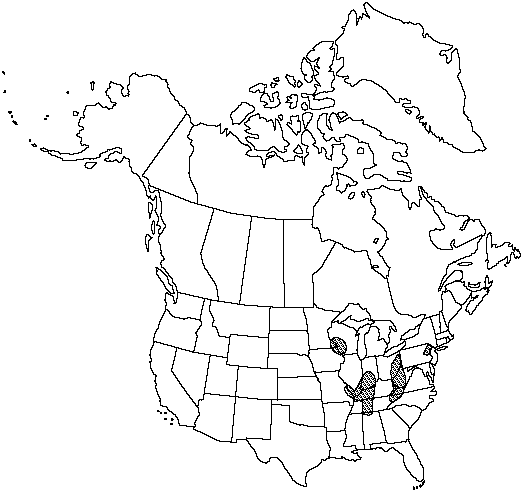Difference between revisions of "Huperzia porophila"
Folia Geobot. Phytotax. 20: 76. 1985.
FNA>Volume Importer |
FNA>Volume Importer |
||
| Line 28: | Line 28: | ||
}}<!-- | }}<!-- | ||
| − | --><span class="statement" id="st- | + | --><span class="statement" id="st-undefined" data-properties=""><b>Shoots </b>erect, determinate, occasionally indeterminate, 12–15 cm, clustered to short-decumbent, leaves of mature portion slightly smaller than leaves of juvenile portion; annual constrictions distinct to indistinct; juvenile growth erect. <b>Leaves</b> reflexed at base, ascending at stem apex (forming cluster) and spreading for most of stem length, sparse, yellow-green (juvenile portion) to yellow-green to green (mature portion), lustrous; largest leaves lanceolate with roughly parallel sides, 5–8 mm; smallest leaves triangular, widest at base, 3–6 mm; margins almost entire with low papillae or a few large teeth; stomates on both surfaces, few (1–25 per 1/2 leaf) on adaxial surface. <b>Gemmiferous</b> branchlets produced in 1–3 pseudowhorls at end of annual growth; gemmae 4–5 × 3–4 mm; lateral leaves 1–1.5 mm wide, acute, widest above middle. <b>Spores</b> 29–38 µm.</span><!-- |
-->{{Treatment/Body | -->{{Treatment/Body | ||
| Line 57: | Line 57: | ||
|publication year=1985 | |publication year=1985 | ||
|special status= | |special status= | ||
| − | |source xml=https://jpend@bitbucket.org/aafc-mbb/fna- | + | |source xml=https://jpend@bitbucket.org/aafc-mbb/fna-data-curation.git/src/9216fc802291cd3df363fd52122300479582ede7/coarse_grained_fna_xml/V2/V2_537.xml |
|genus=Huperzia | |genus=Huperzia | ||
|species=Huperzia porophila | |species=Huperzia porophila | ||
| − | |||
| − | |||
| − | |||
| − | |||
| − | |||
| − | |||
| − | |||
| − | |||
| − | |||
| − | |||
| − | |||
| − | |||
| − | |||
| − | |||
| − | |||
| − | |||
| − | |||
| − | |||
| − | |||
| − | |||
| − | |||
| − | |||
| − | |||
| − | |||
| − | |||
| − | |||
| − | |||
| − | |||
| − | |||
| − | |||
| − | |||
| − | |||
| − | |||
| − | |||
| − | |||
}}<!-- | }}<!-- | ||
-->[[Category:Treatment]][[Category:Huperzia]] | -->[[Category:Treatment]][[Category:Huperzia]] | ||
Revision as of 13:23, 27 July 2019
Shoots erect, determinate, occasionally indeterminate, 12–15 cm, clustered to short-decumbent, leaves of mature portion slightly smaller than leaves of juvenile portion; annual constrictions distinct to indistinct; juvenile growth erect. Leaves reflexed at base, ascending at stem apex (forming cluster) and spreading for most of stem length, sparse, yellow-green (juvenile portion) to yellow-green to green (mature portion), lustrous; largest leaves lanceolate with roughly parallel sides, 5–8 mm; smallest leaves triangular, widest at base, 3–6 mm; margins almost entire with low papillae or a few large teeth; stomates on both surfaces, few (1–25 per 1/2 leaf) on adaxial surface. Gemmiferous branchlets produced in 1–3 pseudowhorls at end of annual growth; gemmae 4–5 × 3–4 mm; lateral leaves 1–1.5 mm wide, acute, widest above middle. Spores 29–38 µm.
Habitat: On damp, shaded, acidic sandstone, rarely on shale or exposed sandstone
Elevation: 50–1200 m
Distribution

Ala., Ill., Ind., Iowa, Ky., Minn., Mo., Ohio, Pa., Tenn., Va., W.Va., Wis.
Discussion
Huperzia porophila occurs in several disjunct populations, most notably in the Driftless Area of Iowa, Minnesota, and Wisconsin. A sterile hybrid between H. porophila and H. lucidula, H. × bartleyi, occurs throughout the range of H. porophila. It reproduces vegetatively by gemmae and is common in habitats intermediate between those of the two parents. In Ohio the hybrid may occupy sites to which H. porophila would otherwise be restricted, thus reducing the sites available for colonization by H. porophila (A. W. Cusick 1987).
Selected References
None.